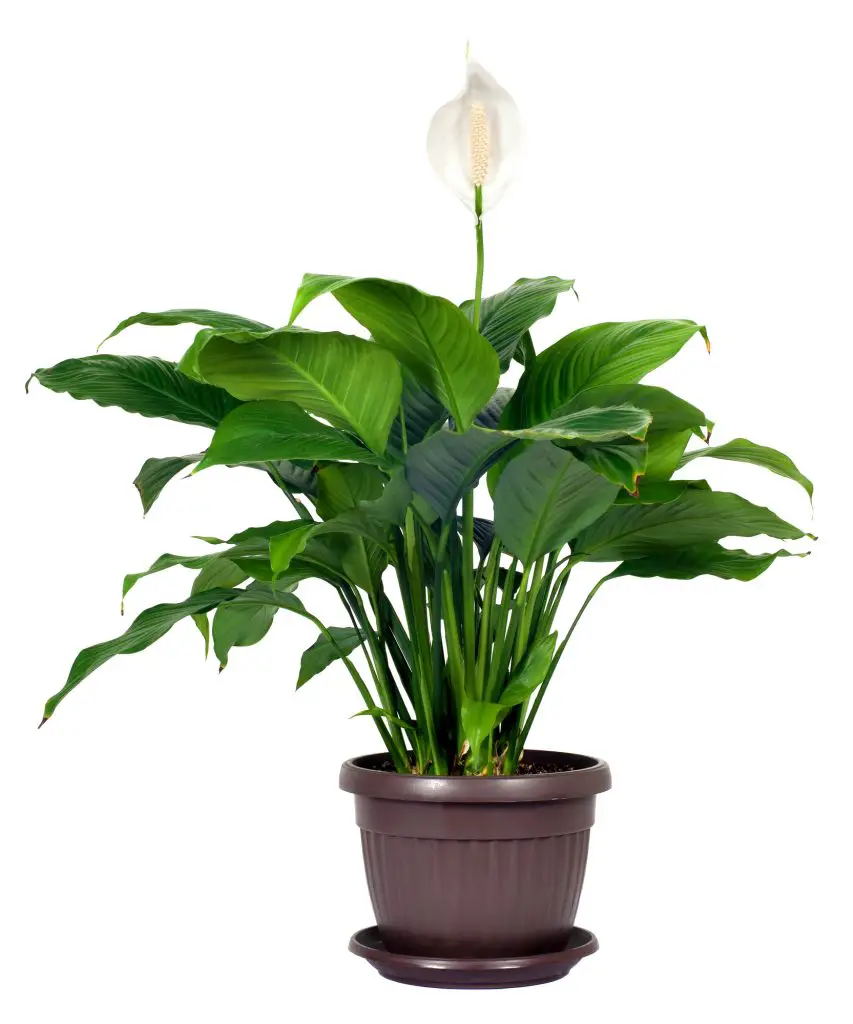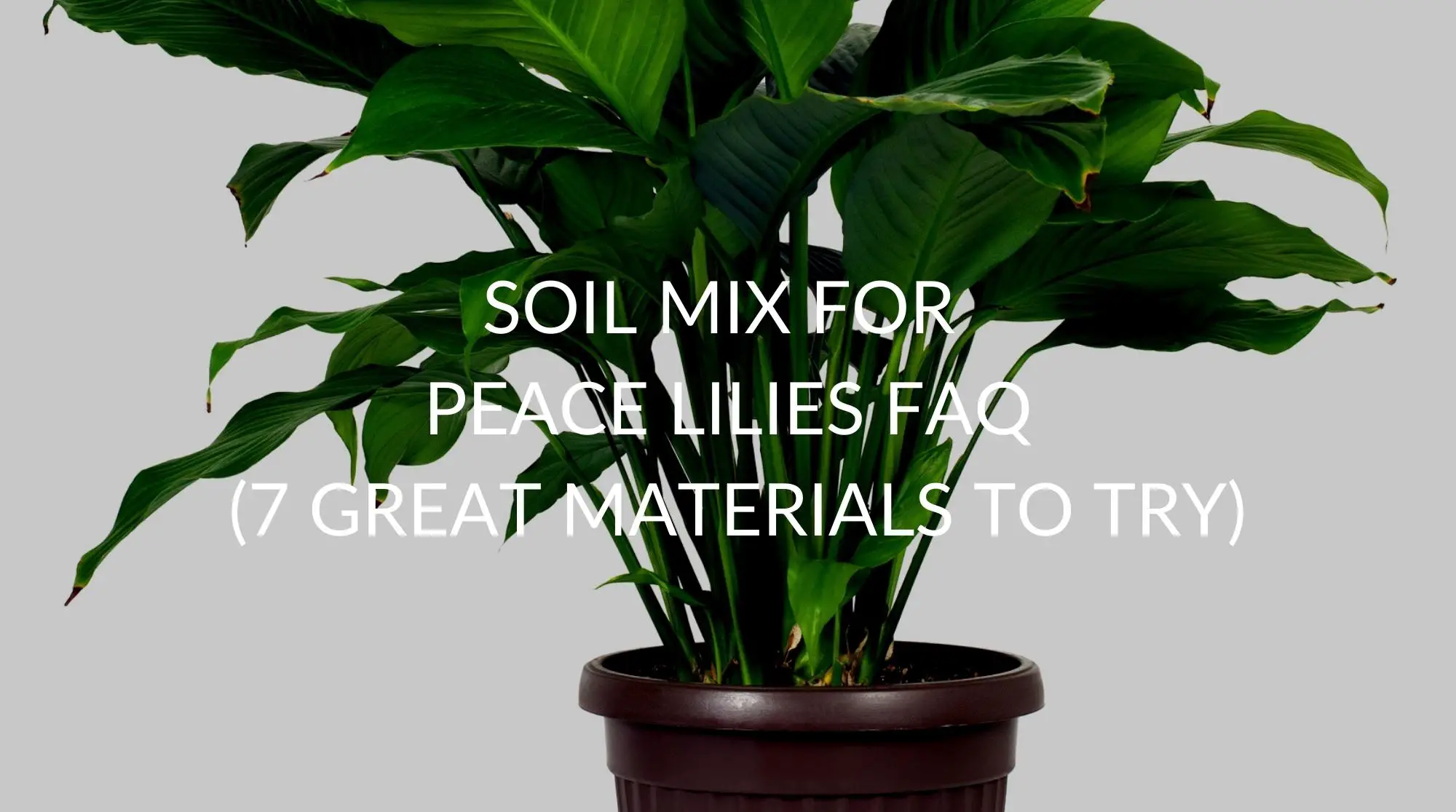Choosing the right soil mix is necessary, if not confusing, part of taking care of peace lilies. In fact, the right potting mix is going to be fundamental to your peace lily’s growth! In this article, you’re going to find all the MUST KNOW information to help you grow happy, healthy peace lilies!
So keep reading to find out.
What Should You Look For In Soil Mix For Peace Lilies?
When choosing the right soil mix, there are a few different qualities you should be looking for, such as:
Drainage
One important part of any good soil mix is soil that drains well. If the soil doesn’t drain well, it will end up staying moist for too long, which can start to suffocate your plants’ roots and even cause root rot.
However, you also need to ensure that the soil mix can hold enough water to stay moist, so your peace lily always has enough! It sounds complicated, but fortunately, there are plenty of different types you can choose from!
pH
You also need to make sure the soil pH is optimal for peace lilies. The ideal pH is between 5.5-6.5. If the pH swings on either side of this, it can often result in your peace lily not being able to take up enough nutrients.
Fortunately, there are ways to change the soil’s pH if you have to. To increase the pH and make it more alkaline, you can add hydrated lime or dolomite lime to it. And if you need to lower the pH and make it more acidic, you can add sulfur or compost to it!
Aeration
It’s also important to make sure that your peace lilies soil is just loose enough to give it proper aeration as well. If you’re not sure whether your soil mix is loose enough, you can use a chopstick or pencil to poke a few holes through it.
Just make sure you don’t do it too often, as you can often end up damaging the roots as well.
Full Of Nutrients
And of course, one of the most important things. You should ensure that your peace lilies soil has enough nutrients to feed them properly. Soil that contains plenty of nitrogen, potassium, and phosphorus is especially good for peace lilies.
If you’re not sure whether your peace lily has this or not, then you can always add a fertilizer. However, you should make sure you’re diluting the fertilizer, as it will probably be too strong for your peace lily, and also remember, you rarely need to do use fertilizer on your peace lily.

How To Tell When Your Soil Mix Isn’t Right
If you’re a beginner or new to keeping peace lilies, you may not be sure whether your soil mix is right for them or not. Here are a few signs to look for that can let you know there could be a problem with the soil.
Brown Tips On Foliage
If your peace lily has brown tips, then it could be because the soil is either holding too much water, not enough water, or has too many nutrients in it.
Rotting Roots
You may also notice that your peace lilies’ roots begin to rot in a soil mix that holds too much water for too long.
Sagging Leaves
The leaves sagging could be a sign of your peace lily not getting enough water. So if you’re watering them regularly, the soil mix you’re using may not be able to hold the water for long enough.
Yellow Foliage
Yellow foliage is another sign that your peace lily isn’t getting enough water. So while it may be because you’re underwatering it, it could also be because the water doesn’t stay in the soil long enough.
What’s The Best Soil For Peace Lilies?
The best soil mix has enough nutrients while also providing the right amount of drainage and water retention. Loamy compost is a great choice; however, regular compost will also work a treat as well.
Or you can try to create your own potting soil, which can be incredibly effective! And the best part is, you can tailor it a lot more to your individual peace lily.
What Should You Add To Home Made Potting Mix
If you’re going to create your own potting mix for your peace lily, there are a few great options you can consider adding. Here are the best materials you can add!
Potting Soil
Potting soil is one of the staple choices most people consider. Potting soil is basically going to be the foundation of your potting mix as it tends to be light, aerated, and filled with plenty of organic and aged natural matter.
Coco Coir
Coco coir is another great choice for your own potting soil mix, and as you may have guessed from the name, it’s actually made from coconuts! Coco coir is particularly good for holding water and letting it drain, though be warned ver time. It can start to become compacted.
Vermiculite
Vermiculite is great because it can hold 3-4 times its own weight in water, which can help keep your plant hydrated while not overwatering it. It also has a neutral pH, so you don’t have to worry about it affecting the pH of the rest of the soil.
It also helps to attract plant nutrients such as potassium, magnesium, and calcium, all of which are great for your peace lily!
Peat Moss
Peat moss, like coco coir, is also great for holding water and nutrients. However, unlike coco coir, it doesn’t compact as easily, so it’s also a great choice for making sure your peace lilies roots remain compact.
Perlite
You may not think perlite would be a good choice because it literally feels like styrofoam, but you couldn’t be further from the truth. Adding perlite to your potting mix can keep the aeration and drainage to a maximum when you need it because it doesn’t absorb water.
Horticultural Sand
While you may think any sand will do, think again. Horticultural sand is a great sand made up of crushed quartz, granite, and sandstone. The main benefit of horticultural sand is that it doesn’t clump together like normal sand. So you don’t have to worry about a build-up of aeration or moisture problems.
Pine Fines
And lastly, pine fines are also a great choice for anyone who needs more aeration in their soil. Pine fines are great because they contain a substance known as lignin which helps them hold their shape over time.
Just remember, while these are just some great choices for homemade soil mix, they’re definitely not your only choices!
How To Make Your Own Soil Mix For Peace Lilies!
Now you know some of the best ingredients to put into your soil mix, you may also want to know how you actually make the mix!
Here are a few step by step guides:
Method 1:
The first method involves choosing the right pot to build your potting mix in. You want to make sure there are holes in the bottom to ensure that enough water is draining out and also to make sure you’re using the right material in your pot too.
Plastic is a poor choice, as it makes it harder for water to escape. But any clay or ceramic pot will work fine.
Once you’ve got the right pot, you just need to do the following:
Add Your Water Retaining Material
The first step is to add the water-retaining material of your choice. Peat moss and coco coir are great choices as not only will they hold water, but they’ll also help to hold plenty of nutrients as well.
And once you’ve chosen one, you should fill the pot halfway with it.
Next The Material That Improves Drainage
Now that you’ve got the material that retains water, you want to make sure not all of the water is being retained, so you’ll need a material that improves drainage as well. I personally like to use perlite; however, vermiculite and horticultural sand can make great choices as well.
Make sure that about the third of the pot is to be filled with this; however, if you do go over 30%, it’s definitely not the end of the world, and your peace lily will still be fine.
If you’re not sure that your peace lily is going to get enough nutrients, you choose vermiculite over perlite.
Making Sure There’s Enough Nutrients
Lastly, you’ll need to make sure your soil mix has enough nutrients in it as well; otherwise, your peace lily is never going to survive. You should add homemade compost/humus to the pot and let this make up the last fifth of the compost mix.
Mix Them Together And Add Your Peace Lily
Now all you need to do is mix all the materials together and add your peace lily, and the job is done! Just make sure you’re being careful, so you don’t damage your plants’ roots.
Method 2:
Now you have a rough idea of how to make your own potting mix, here’s another method:
Ingredients
- Orchid Bark
- Coco Coir
- Perlite
- Activated Charcoal
- Worm Castings
Mixing
Mix 5 parts orchid bark, 5 parts perlite, 4 parts coco coir, 2 parts activated charcoal, and 2 parts worm castings together. Once you’ve done this, just add them to the pot again, and you’ll have the perfect potting soil for your peace lily!
FAQ
Here are some commonly asked questions about peace lily soil mixes.
Do Peace Lilies Like Moist Soil
Peace lilies like soil that is constantly moist but not waterlogged. To see if this is the case, poke your finger into the soil. If you notice that it’s moist about a knuckle deep, then you’re fine. If all of the soil is moist, you don’t need to water them just yet, and if the soil is dry, you should water them again.
Can You Use Succulent Soil For Peace Lilies?
Succulent soil is a great choice for any peace lily, so if you don’t want to make your own soil mix, it’s a great alternative. This is even better for beginners who aren’t quite sure they want to make their own soil mix just yet. So if you have some lying around, you can definitely use it!
Do Peace Lilies Like Acidic Soil?
Peace lilies like soil that is ever so slightly acidic. You should try to keep the pH of your soil between 5.5-6.5. If you notice that your peace lily is too acidic, try adding hydrated lime to the soil. And if you notice it’s not acidic enough, try adding coffee grounds!
Can You Use Cactus Soil For Peace Lilies?
Cactus soil is also a great soil mix for your peace lilies, so if you want to just use that, it’s more than good enough. The main benefits of using cactus soil are that it has great aeration, drains well, and is slightly acidic.
Recap
As you can see, choosing the ingredients for your soil mix and creating it isn’t hard. In fact, when you know what you’re looking for, it’s actually incredibly simple. So now you just need to go out and give it a try yourself!
If you liked this article, make sure you check out the rest of the website! Otherwise, have a great day.







